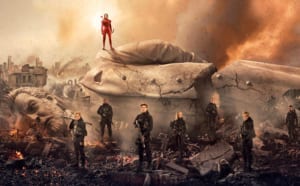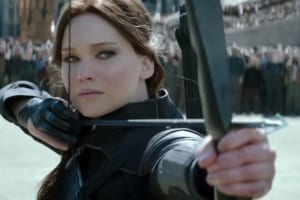The fourth and final Hunger Games movie, Mockingjay: Part 2 was released to the world on November 4th this year and, generally speaking, received positively. Rotten Tomatoes, metacritic.com and the Internet Movie Database all note high reviews, while the reaction of big magazine critics range from excited to a bit let down. One of, if not the, most criticized decisions may be the fact that the third book, Mockingjay, was split into a third and fourth movie, instead of being produced as just one, and both EW’s Leah Greenblatt and The Guardians’ Mark Germode agree that this has significantly affected the pacing of both movies.
I will have to take up the cudgels for this decision, though. Mockingjay is a tightly packed, intense novel that allows  neither the readers nor Katniss to really draw a breath or take even a short break, and splitting it into two movies allows, among other things, the further continuation of a custom that started with the first Hunger Games movie: Depicting other characters’ conversations and actions that our limited first person narrator Katniss in the novels has no idea of.
neither the readers nor Katniss to really draw a breath or take even a short break, and splitting it into two movies allows, among other things, the further continuation of a custom that started with the first Hunger Games movie: Depicting other characters’ conversations and actions that our limited first person narrator Katniss in the novels has no idea of.
Among these conversations are those between President Snow and his unnamed female advisor as well as those between Plutarch Heavensbee and President Alma Coin. Though the first Mockingjay movie included multiple scenes showing Heavensbee and Coin conferring over the revolution in general and Katniss role in it specifically, the final one only has one and that is the one where Coin and Heavensbee discuss the consequences of Katniss sneaking out of 13 and onto the battlefield in the Capitol despite direct orders not do to so. Coin makes it clear to the Head Gamemaker that whatever Katniss does, it must seem like she does it on their orders and as if she is still playing their game.
The fact that in the movie, the Mockingjay is not sent onto the battlefield, but instead sneaks onto it, committing insubordination, adds depth to two scenes: the one at Finnick’s and Annie’s wedding, where Prim and Katniss dance together – directly after she decided to sneak out of 13 to kill Snow and was told by Johanna that “Everyone can kill anyone, even a president. You just have to be ready to sacrifice yourself” – and to the scene where Boggs tells Katniss that Coin likely plans to kill her during her stay in the Capitol because Coin realized that she cannot control her. It is remarkably easy for the viewer to see Katniss’ act of insubordination as the thing that finally alerted Coin to just how uncontrollable she is and led her to send Peeta after her into the Capitol war zone despite the real (and, as the movie implies, on Coins part, calculated) risk that he might kill her.
Coin makes the same decision in the book, but Katniss does not. In the novel she is, as mentioned already, sent into the Capitol on the president’s orders, as one soldier among many who has undergone training and who has had to pass a specific exam to be seen as fit for duty. This is something that Katniss for a change does not have to go through on her own:  Johanna Mason, another victor and survivor of the Quarter Quell who was captured and tortured by Snow also wants to go to war and is thus put through the same training as Katniss. The two become fast friends, even moving into one of 13s compartments together.
Johanna Mason, another victor and survivor of the Quarter Quell who was captured and tortured by Snow also wants to go to war and is thus put through the same training as Katniss. The two become fast friends, even moving into one of 13s compartments together.
I have to admit, I was disappointed that these scenes were cut, as I had hoped that, because the book was split into two movies, they would be adapted. Katniss is not trained in combat and she also is not that naturally excellent at it, just like she struggles following orders if she disapproves of them. This is something that gets dealt with in this specific chopped part of the book. And, maybe more importantly, these scenes add further depth to the relationship between the two former victors and to Johanna’s character and especially highlight how she still struggles with PTSD after what she went through in the Capitol. While her addiction to painkillers, also a direct result, made it into the movies, this as well as her later withdrawal and recovery did not.
At the same time, I find this to be an understandable decision. The Hunger Games: Mockingjay Part II is a bit longer than two hours and the pacing seems at the same time weirdly compressed and drawn out. And this training sequence is not the only thing left out of the movies: Scenes showing how Peeta’s hijacking is dealt with more thoroughly are cut, as are several hunting scenes with Katniss and Gale and the slowly growing distance between them. At some points, it feels like the movie is quite simply rushing towards the juicier bits of the book, like the taking of the Nut and the invasion of the Capitol.
That is also understandable, as action, quite simply, still sells best and especially the Capitol scenes are something into which quite a bit of effort was put. The scene in the underground, when the Star Squad is trying to escape the unseen Capitol mutts, remains creepily scary even the second time around, and the jumpscare scene when the mutts finally do attack – in a moment where one truly believes that the characters made it to safety – is perfectly executed.
Contrasting this, then, with the boutique and Tigris, who seems like nothing more than a slighted weirdo, makes the horrors that Katniss and her few surviving friends just went through stand out even stronger. It is a contrast that appeared once before in the movie already, when Unit 451 was hiding in a luxurious apartment after triggering the black oil pod and loosing Boggs, the Leeg sisters and Mitchell, and that we also see again and again in the other movies, too. Contrasting the luxury that the Capitol citizens and President Snow live in and the daily reality first of hunger and poverty and then later on, state sanctioned violence, war and death that the District citizens have to deal with is one of the big consistencies of The Hunger Games movies.
Another, less praiseworthy consistency is the fact that Katniss remains remarkably beautiful throughout the movies. When we first meet her, she is far from being the ridiculously thin, almost starved kid that the book makes us envision and she remains remarkably healthy looking during and after both of her stays in the Arena. Essentially the movies do the same thing to Katniss that the Capitol surgeons do after the Hunger Games: Erase all physical traces of her suffering.
This becomes even more obvious in Mockingjay Part II: According to the novel, the bombs that killed Primrose Everdeen also burned Katniss, including singing her hair off, meaning that it looks uneven and odd, but movie – Katniss continues to have a head of perfectly healthy, glossy, thick dark brown hair. On peut augmenter cette dose jusqu’à 100 mg et elle peut être réduite jusqu’à 25 mg. La prise de acheter Cialis sans ordonnance est permise une fois par jour et on le préscrit seulement pour les personnes après 18 ans.  Peeta’s prosthetic leg, that replaces the one he lost during the 74th Hunger Games, gets lost in the book to movie translation, too, and even secondary characters get this kind of treatment: When Katniss is allowed entry to President Snow’s quarters by Paylor, she describes the Commander as looking “even more beat up than she did at the hospital”, but in the movie, Paylor looks as if she had just come back from a long vacation.
Peeta’s prosthetic leg, that replaces the one he lost during the 74th Hunger Games, gets lost in the book to movie translation, too, and even secondary characters get this kind of treatment: When Katniss is allowed entry to President Snow’s quarters by Paylor, she describes the Commander as looking “even more beat up than she did at the hospital”, but in the movie, Paylor looks as if she had just come back from a long vacation.
What also is not shown is just how much time passed between the bomb blast in front of the President’s Mansion and his execution. The viewer can only guess how much time passed between scenes due to tiny details that changed, like the amount of snow in the Capitol when Katniss moves to the President’s mansion or the bloom of a white rose that Katniss plucked from Snow’s prison and that is shown again in the next scene, when Gale is coming to tell her that Coin wants to speak to her.
But in the book, it is explicitly stated that Katniss first spends a long time confined to a Hospital bed, recovering from her injuries and then wandering around Snow’s mansion without any sort of destination, not speaking to anyone and occasionally hiding in closets filled with furs, old bathtubs or library cabinets before stumbling onto Snow’s carters for an unspecified amount of time, but definitely several days, with a bracelet around her wrist that says “mentally disoriented”. Showing something like this on screen, maybe in a montage of Katniss wandering around the mansion while the sun and the moon flit by a window, would have been remarkably easy and I, quite frankly, do not understand why it was not done.
Then again, these are some of the scenes in the book where Katniss trauma and depression are the most obvious to the reader. The main reason she ever did anything and one of the few people that made her believe in the possibility of goodness still existing in the world, her sister Prim, is dead and gone forever, and this leads, among other things, to Katniss refusing to speak at all, to anyone, until Snow tells her that it was Coin who sent the bombs, not him. The Mockingjay describes herself as “a badly burned girl with no wings” who is buried by grief, whose skin is a mixture of grafts, burns and undamaged areas, a bizarre “patchwork quilt” and whose condition is described as deadened and drugged. The movie glosses over this, just as it glosses over Katniss struggling with Snow telling her that it was Coin who bombed the Capitol children and the medics attempting to help them – a struggle that leads Katniss back to hiding in cabinets and nightmares out of which she awakens screaming. Even after she kills Coin and returns to 12, book – Katniss is unable to get herself to do anything but sit around, sleep, consume food and grieve, and when she does get herself to do things, like a trip into the study or to the woods, it leaves her tired and anxious. This only changes when Buttercup’s returns to 12 triggers Katniss breakdown over Prim’s death: afterwards, she comes back to live, but with “many lost days”. And while the breakdown made it into the movie, the days around it, during which Katniss gives herself to apathy and grief, again did not.
Not showing the full extent of Katniss’ depression and grief was not a good decision. Glossing over just how much she struggles with getting back to any semblance of happiness makes it seem easier than it actually was for her. People do struggle with trauma, with an inability to function after something terrible happened to them, with depression, nightmares and PTSD and it is absolutely okay to portray this, extensively, in TV shows and movies. I would even argue that it is important – after all, the stories we consume shape the way we see the world, and if we are only ever shown that characters bounce back from trauma, it becomes easier to eventually assume that this is how real people react, too.
But the movie’s way of downplaying the way the characters struggle with the effects of the Hunger Games as well as the rebellion is not just limited to Katniss: While we occasionally see Finnick tie knots into a rope on screen, but he never explains that this is something that helps him cope and we never see him teach it to Katniss, either.  That Annie Cresta struggles with deciding what is real and what is not is mentioned in passing, but whenever we see her, she is always entirely there and never drifts off into her own world. Doctor Aurelius, the shrink treating Katniss and Peeta, never makes any sort of appearance at all. Peeta has no burn scars anywhere. The mental illness that made Katniss’ mother shut down completely after her husband’s death is never actually called an illness, as it is in the books, and no one states that she can never return to 12 because the place is too painful for her to bear. That the old inhabitants of District 12 return and rebuild the District, cleaning the district of the corpses and creating a mass grave did not make it into the movie, either, instead Katniss just stumbles onto a beautiful meadow while hunting. To me personally, as someone who always loved the way the effects of war on people and places were shown in the books, the way this was dealt with remains the biggest disappointment – especially in a society that is unable to really acknowledge and treat the trauma that real victims of war and violence suffer from.
That Annie Cresta struggles with deciding what is real and what is not is mentioned in passing, but whenever we see her, she is always entirely there and never drifts off into her own world. Doctor Aurelius, the shrink treating Katniss and Peeta, never makes any sort of appearance at all. Peeta has no burn scars anywhere. The mental illness that made Katniss’ mother shut down completely after her husband’s death is never actually called an illness, as it is in the books, and no one states that she can never return to 12 because the place is too painful for her to bear. That the old inhabitants of District 12 return and rebuild the District, cleaning the district of the corpses and creating a mass grave did not make it into the movie, either, instead Katniss just stumbles onto a beautiful meadow while hunting. To me personally, as someone who always loved the way the effects of war on people and places were shown in the books, the way this was dealt with remains the biggest disappointment – especially in a society that is unable to really acknowledge and treat the trauma that real victims of war and violence suffer from.
Even in the final scene, showing Katniss sitting under a tree on the aforementioned meadow with a newborn in her arms, telling her baby that she still has nightmares that will never go away and needs to play a game in her head, listing every act of kindness she has ever witnessed, while Peeta plays with their older child in a meadow is guilty of this. In the books, Katniss struggles with how to explain the rebellion and the war and her nightmares and the fact that she still cannot get out of bed on some mornings to them and then she thinks about how her children are, unknowingly, playing on a mass grave. This last horrifying, bittersweet detail does not make it into the movie at all, partly because the fact that people other than Katniss, Haymitch and Peeta returned to 12 and started rebuilding it by first burying their dead also did not. Instead, when Katniss first leaves her home to go hunting, she just stumbles upon this perfect, wide, lush meadow on which she then later sits with her children and partner in a syrupy – sweet ending whose bright colors gloss over all the dark details of the book.

